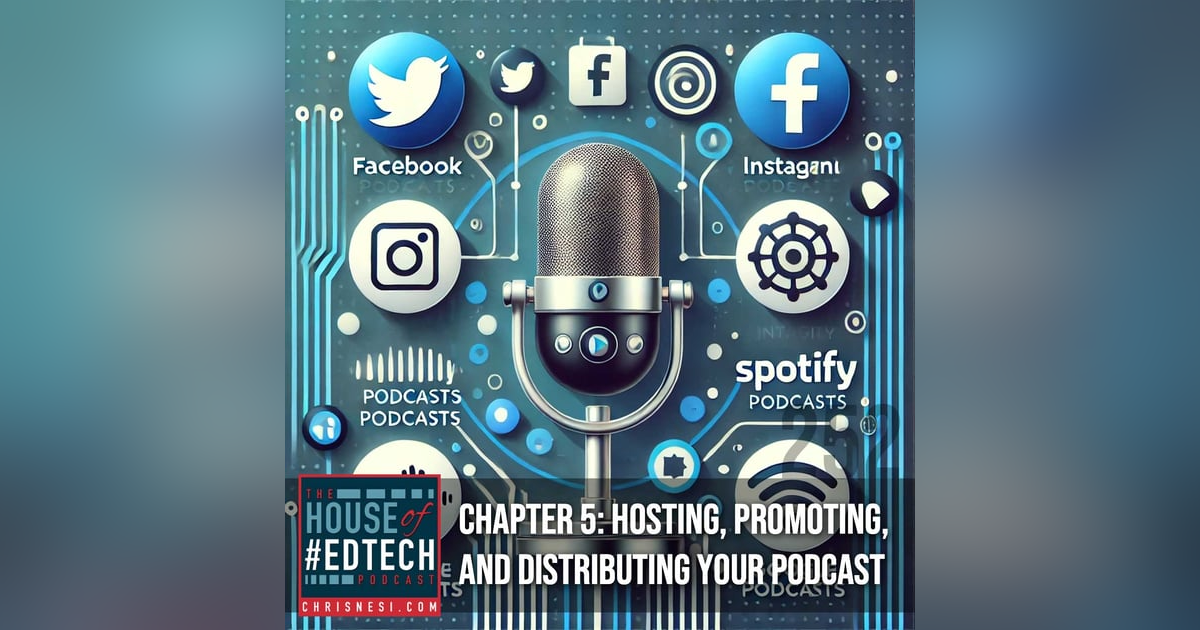Chapter 5: Hosting, Promoting, and Distributing Your Podcast - HoET252

Today, we're diving into Chapter 5 from my book . This chapter is all about what comes after you hit record – hosting, promoting, and distributing your podcast to ensure it reaches as many ears as possible.
Welcome to House of #EdTech! Today, we're diving into Chapter 5 from my book I Like to Podcast and You Will Too!: A House of #EdTech Guide to Podcasting. This chapter is all about what comes after you hit record – hosting, promoting, and distributing your podcast to ensure it reaches as many ears as possible. We'll cover essential strategies to help you expand your audience and engage listeners effectively.
Key Takeaways:
1. What is a Podcast Media Host?
- A media host stores and distributes your podcast's audio files, allowing listeners to access episodes through platforms like Apple Podcasts or Spotify. Choose a media host that fits your needs, offering options such as analytics, website hosting, and RSS feed management. Popular hosting platforms include:
- Spotify for Podcasters, Blubrry, Buzzsprout, Captivate, Castos, Libsyn (promo code NESI), Podbean, Simplecast, Spreaker, and Transistor.
- Research hosting options carefully to find a plan that best suits your podcast's goals and budget.
2. Submitting to Directories
- Get your podcast listed on major directories, including Apple Podcasts, Spotify, so it can be discovered by a wider audience. Submission involves creating an account, entering your podcast’s RSS feed URL, and waiting for verification.
- Once your podcast is approved, these platforms offer features such as subscriber stats, reviews, and categorization options to improve your show’s visibility.
3. Social Media Promotion Strategies
- Share Regular Updates: Consistently promote new episodes on social media platforms like Twitter, Facebook, Instagram, and LinkedIn. Engage with your followers by responding to comments and questions.
- Collaborate for Growth: Partner with other podcasters or influencers in your niche to reach new listeners and build credibility.
- Platform-Specific Tips:
- Twitter/X: Post real-time updates, engage in conversations, and use trending hashtags.
- Threads: Instagram's answer to the decline of Twitter/X
- Instagram: Share behind-the-scenes content and episode snippets. Stories can showcase your creative process.
- Facebook: Leverage groups and pages to engage with targeted audiences.
- LinkedIn: Share articles or insights on topics related to your podcast to connect with a professional audience.
- Consider Paid Advertising: Facebook and Instagram ads can effectively broaden your reach, especially when targeted toward specific interests or demographics.
4. Building an Email List
- An email list allows you to maintain a direct line to your audience, even when they’re not actively listening. Send out episode announcements, exclusive offers, or bonus content to keep your listeners engaged.
- Incentivize sign-ups by offering exclusive content, early episode releases, or other perks. Check out services like Mailchimp, ConvertKit, or HubSpot to get started with list management.
Feedback:
Martin Byford-Rew has launched the #EdTech Stuff Podcast! He shared a voicemail with me about a recording he did that didn't turn out great and what he did. Check out his podcast!
ASK QUESTIONS, SHARE YOUR FEEDBACK, AND CONNECT WITH ME
- Comment on the show notes below
- Click here to leave a voicemail
- Subscribe & Follow the House of #EdTech
- Email feedback@chrisnesi.com (audio files welcome)
THANK YOU TO MY AWESOME SUPPORTERS!
CLICK HERE TO BECOME AWESOME!
- Leo Calbusch - @leocalbusch
- Bryon Carpenter - bryoncarpenter.com
- Erin Cummings - @ErinC_CCIU
- Peggy George - Classroom 2.0 LIVE
- Jeff Herb - instructionaltechtalk.com
- Matt Miller - Ditch That Textbook
CHECK OUT MORE EDUCATION PODCAST NETWORK SHOWS
SUPPORT THESE BRANDS AND COMPANIES AND YOU WILL BE SUPPORTING THE PODCAST.
DISCLOSURE
This post may contain links to products or services with which I have an affiliate relationship. I may receive commissions or bonuses from your actions on such links.
















